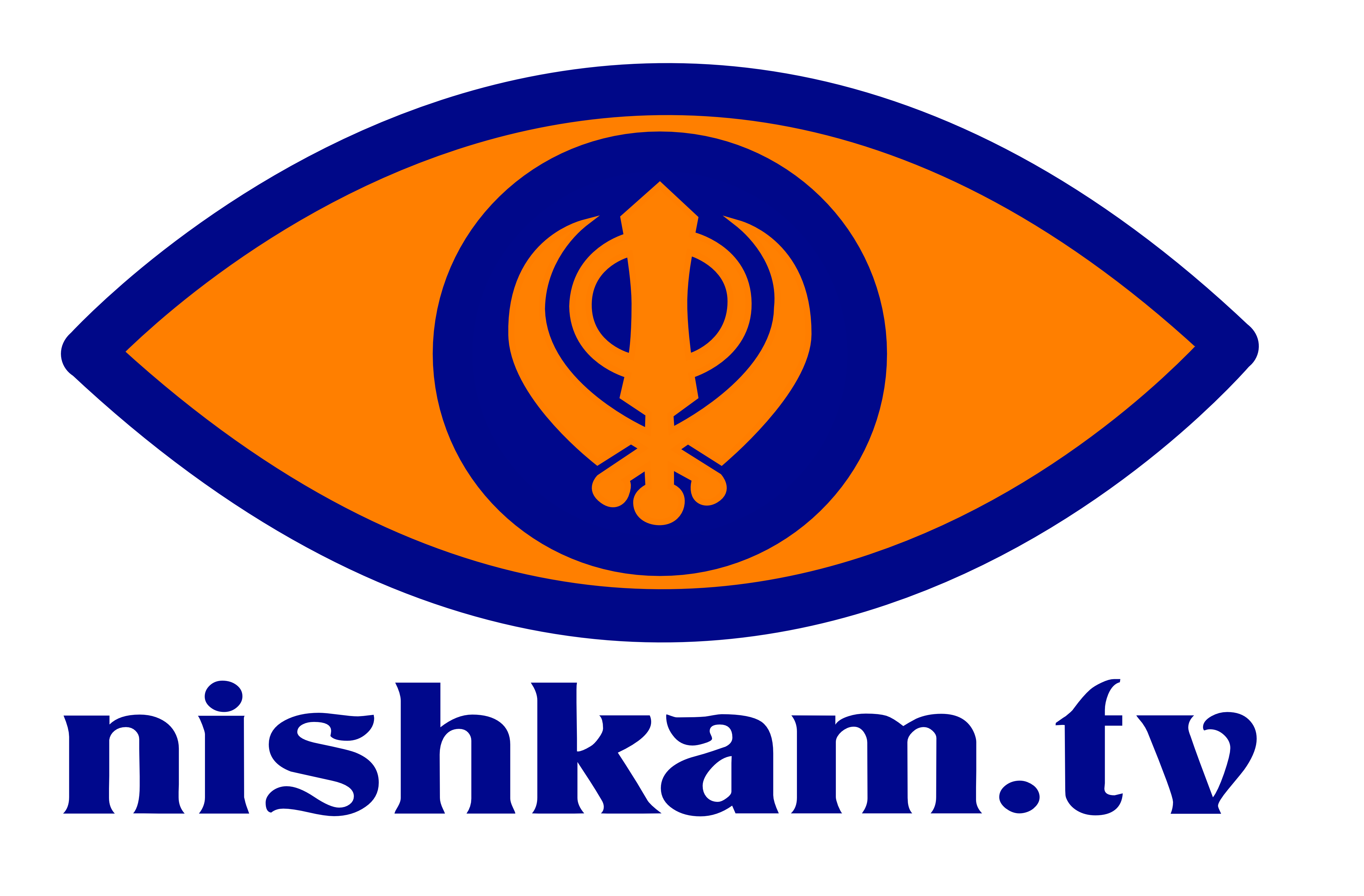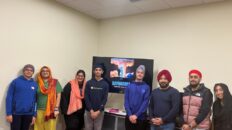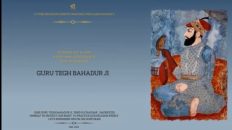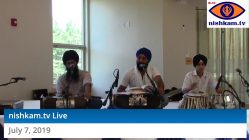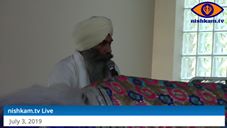ਦੂਰਿ ਨ ਜਾਨਾ ਅੰਤਰਿ ਮਾਨਾ ਹਰਿ ਕਾ ਮਹਲੁ ਪਛਾਨਾ ॥ ਨਾਨਕ ਵੈਸਾਖੀਂ ਪ੍ਰਭੁ ਪਾਵੈ ਸੁਰਤਿ ਸਬਦਿ ਮਨੁ ਮਾਨਾ ॥੬॥
I’ll know You are not far, I’ll acknowledge You are within; I’ll recognize the Mansion of the All-Pervasive One. Nanak: In Vaisakh the Beloved is discovered when consciousness has Wisdom and mind has Faith.
Raag Tukhaari – Guru Nanak Dev Ji – Sri Guru Granth Sahib Ji – Ang 1108
Guru Nanak has taken the role of “spouse or lover” of the Divine Beloved. Vaisakh is glorious; branches are adorning themselves. Lover watches at the door, All-Pervasive! Be gracious and enter! Come home, Beloved, take me across the impassable ocean; without You, I am not worth half a penny. If I were to become pleasing to You, who could appraise my worth? See show me, Darling! I’ll know You are not far, and I’ll acknowledge You are within; I’ll recognize the Mansion of All-Pervasive. Nanak: In Vaisakhi, the Beloved is discovered when consciousness has Wisdom and mind has faith.
– First Sovereign, Guru Granth Sahib, 1107
The whole Shabad is one section of Guru Nanak’s Barah Maha in Rag Tukhari and actually makes more sense if we study the whole Bani. It starts with the month of Chet which is all about the preparation of the mind and body and then transfers into Vaisakh which is all about devotion and commitment and fruit of preparation. So, the two lines are essentially exposing two things:
1. Waheguru is not “outside” in some space or sacred place. Waheguru is everywhere but the most important point is Waheguru is within us (we are divine – “man tun jot saroop hai, apna mul pachhan…”). So, the realization of “dur na jana antar mana…” that the House of Waheguru is within.
2. Secondly, Vaisakh (the month) will be considered fruitful (remember that Vaisakh is the time of harvest) when the mind and body are aligned and devoted to the Prabhu (Waheguru). That fruitfulness comes from aligning consciousness (surat) to Shabad and mind (man) to Faith (acceptance).
Keeping above mentioned Shabad’s sentiments to utmost importance in our minds and believe that wherever Sikh Sangat is, even if we are “separated” from our physical Gurdwara building, the Shabad is always with us, Vaisakhi Diwan was celebrated virtually.
On April 19, 2020, NESSC in collaboration with Nishkam TV, held a Virtual Vaisakhi Diwan which brought the community of Westborough Gurdwara Sahib together to celebrate – Vaisakhi, an important day in Sikh history. Vaisakhi commemorates the birth of the Khalsa and the formation of the Panj Pyare by Guru Gobind Singh Ji in the year 1699. Since many Sikh communities, including our own, we’re unable to gather in-person, the virtual diwan provided a similar feeling with two hours of noteworthy segments displaying how families at our Gurdwara are celebrating Vaisakhi at home. Thanks to the Nishkam TV platform, everyone was able to experience togetherness while practicing social distancing during these unprecedented times and remember this revolutionary day in Sikh History.
The Virtual Vaisakhi program began with an introduction by host Tanisha Kaur explaining the definite purpose of the diwan and welcoming everyone to what turned out to be a unique celebration of Vaisakhi. She then introduced the president of NESSC Baljit Singh Nijjar, who wished everyone a Happy Vaisakhi and established an optimistic atmosphere. After this introduction, Tanisha began to launch the first segment of the program, which was essays related to Sikhi related topics such as Panj Pyare, the Panj Kakaars, Ardas, Hukam, and Seva. The kids delightfully spoke in Punjabi about these topics and started the Diwan off by sharing their knowledge.
Siddakk Singh also played a part in co-hosting the program and introduced the next segment, which was Punjabi poems read by Khalsa school students and alumni. These poems captured the true essence of Vaisakhi because they talked about the determination of Sikhs throughout history. For example, the poem read by Hridhveer Singh Khurana and Divraj Singh, “Singh Marno Kadhay Na Dardhay” narrated how Singhs had no fear and fought with true resilience during the wars. The rest of the poems explored similar ideas, and the students showed that they were genuinely proud to be reciting these poems.
Kirtan, done by members of our Sangat at home, also lifted the spirits of everyone and commemorated the particular day’s significance. Siddakk introduced all of the families who recorded their Shabads. The Shabads recited, such as “Deh Shiva Bar Mohe Ehai,” written by Guru Gobind Singh Ji, describes the power of Hukam and explains the quality needed to be a part of the Khalsa Panth-To live with courage and bravery to the highest levels of righteousness. Sikhs should have no anxiety from the righteous fight and always trust in Waheguru.
The Kirtan Segment was an ideal segway into the young kids of Khalsa School’s execution of Chaupai Sahib, a part of Nitnem and in the Dasam Granth written by Guru Gobind Singh Ji. Chaupai sahib is a Benti or request and offers protection and security when completed. When listening to the younger kids, it was prominent that they all practiced and humbly recited the 25 Pauris of the Bani.
Before a unique slideshow put together by Priyal Kaur, president Baljit Singh Nijjar and host Tanisha thanked everyone for tuning into the pre-recorded live program. Siddakk Singh also introduced the slideshow and explained how he hoped this would put a smile on everyone’s face and reminded everyone that “Even when we’re apart, we are together, as a community.” The hosts all wished everyone a Happy Vaisakhi once again.
Our Virtual Vaisakhi program was one of the first of it’s kind and created an uplifting tone in everyone’s household. It offered a chance for our community to innovate and collaborate after being apart for nearly two months. With the ability to create special pre-recorded programs, along with the live weekly Diwan on the Nishkam TV YouTube channel, the members of our Sangat were able to feel as if they never stopped attending Gurdwara Sahib.
We are all grateful to have a close-knit Gurdwara community tied together by our love for Sikhi. Thank you to the organizers of the Diwan Sarabjit Kaur Kapoor and Amarjit Kaur Nijjar and the Nishkam TV production team for producing an unforgettable Diwan.
Bole So Nihal. Sat Sri Akal.
